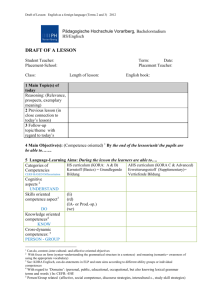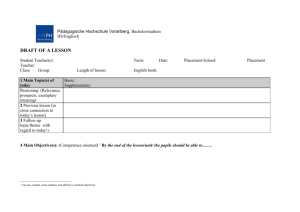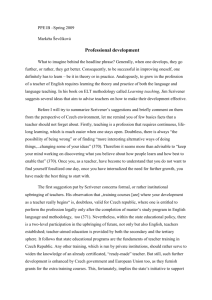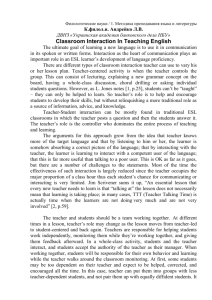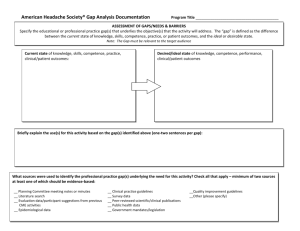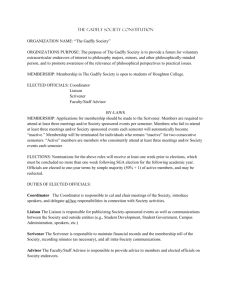draft of a lesson
advertisement
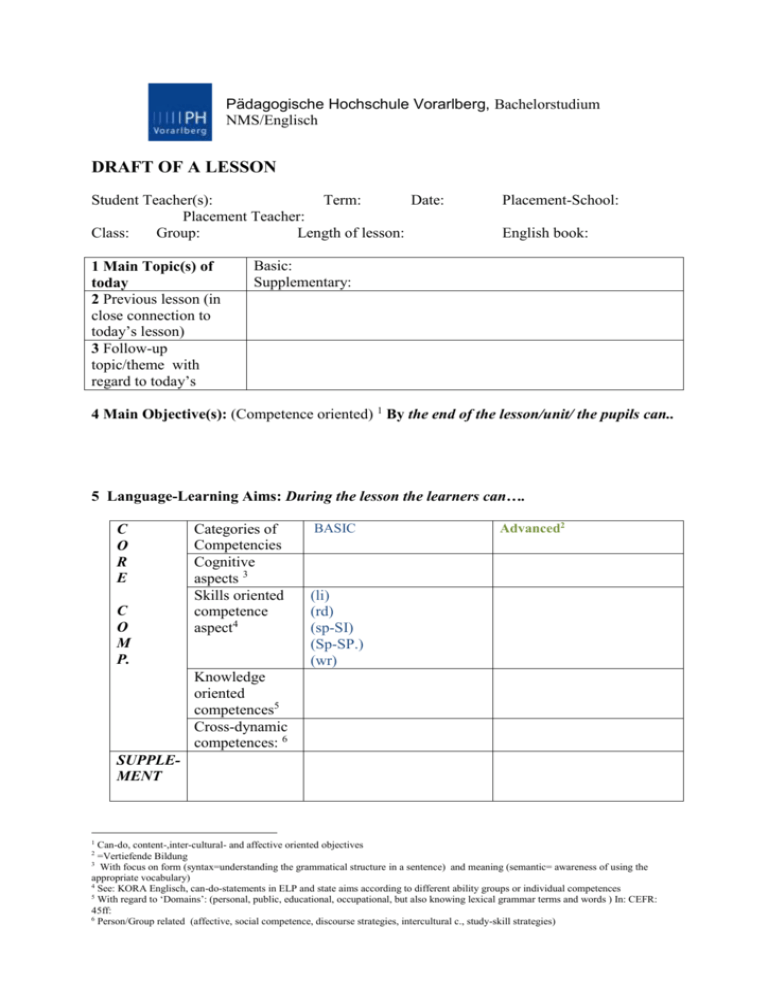
Pädagogische Hochschule Vorarlberg, Bachelorstudium NMS/Englisch DRAFT OF A LESSON Student Teacher(s): Term: Date: Placement Teacher: Class: Group: Length of lesson: 1 Main Topic(s) of today 2 Previous lesson (in close connection to today’s lesson) 3 Follow-up topic/theme with regard to today’s Placement-School: English book: Basic: Supplementary: 4 Main Objective(s): (Competence oriented) 1 By the end of the lesson/unit/ the pupils can.. 5 Language-Learning Aims: During the lesson the learners can…. C O R E C O M P. Categories of Competencies Cognitive aspects 3 Skills oriented competence aspect4 BASIC Advanced2 (li) (rd) (sp-SI) (Sp-SP.) (wr) Knowledge oriented competences5 Cross-dynamic competences: 6 SUPPLEMENT 1 Can-do, content-,inter-cultural- and affective oriented objectives =Vertiefende Bildung 3 With focus on form (syntax=understanding the grammatical structure in a sentence) and meaning (semantic= awareness of using the appropriate vocabulary) 4 See: KORA Englisch, can-do-statements in ELP and state aims according to different ability groups or individual competences 5 With regard to ‘Domains’: (personal, public, educational, occupational, but also knowing lexical grammar terms and words ) In: CEFR: 45ff: 6 Person/Group related (affective, social competence, discourse strategies, intercultural c., study-skill strategies) 2 7 Summary of essential and topic related information (i.e. specific vocabulary, grammar, intercultural, detailed background knowledge, sociolinguistic facts) References: 8 Media and their Purpose 10 PROCEDURE OF LESSON Teaching/Learning points7 b. Teaching / Learning Stages8 c. Time allocated a. Teacher’s Activities: (Setting tasks, methodological / didactical approaches / techniques) Pupil’s Activities (Performing tasks, skill orientated language practice) Teaching model/ Class Management/ Seating Supporting media Topic? What ‘skill’? What language competence is taught/is practised? (i.e. Writing a report about one’s week, Talk about one’s future plans) See English Standards 11ff i.e. Presenting Phase, Practice Phase, Product phase (Richards/Rodgers 2001): Or: Pre-task Phase (Introduction to topic and task), Task-Cycle (Task, Planning, Report), Language Focus (Analysis, Practice) by Jane Willis,1996 or: Lead in, set-up, run. Post activity(Scrivener 2005), or: ARC= Authentic- use Phase, Restricted-use Phase, Clarification- and- Focus Phase (Scrivener 2005) 7 8 10 PROCEDURE OF LESSON Teaching/Learning points9 b. Teaching / Learning Stages10 c. Time allocated a. Teacher’s Activities: (Setting tasks, methodological / didactical approaches / techniques) Pupil’s Activities (Performing tasks, skill orientated language practice) Teaching model/ Class Management/ Seating Supporting media Topic? What ‘skill’? What language competence is taught/is practised? (i.e. Writing a report about one’s week, Talk about one’s future plans) See English Standards 11ff i.e. Presenting Phase, Practice Phase, Product phase (Richards/Rodgers 2001): Or: Pre-task Phase (Introduction to topic and task), Task-Cycle (Task, Planning, Report), Language Focus (Analysis, Practice) by Jane Willis,1996 or: Lead in, set-up, run. Post activity(Scrivener 2005), or: ARC= Authentic- use Phase, Restricted-use Phase, Clarification- and- Focus Phase (Scrivener 2005) 9 10 11 Lesson Preview: 12 Lesson Review: Findings to consider for future lesson planning and teaching 12.1 Trainers’ feedback 12.2 Personal notes 12.3 What I particularly want to consider in the implementation of teaching
